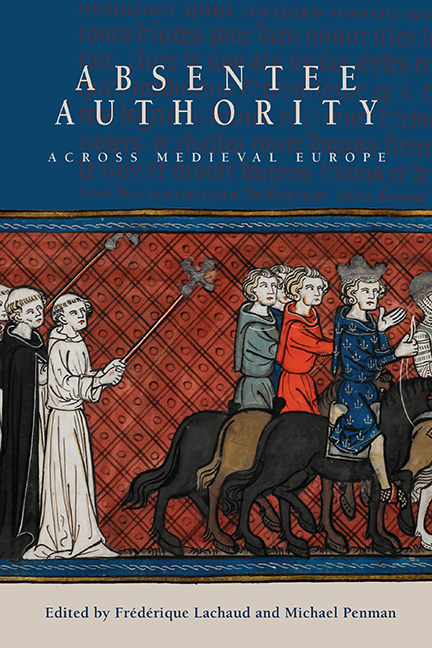Book contents
- Frontmatter
- Contents
- List of Illustrations
- List of Contributors
- Acknowledgements
- List of Abbreviations
- Introduction: Absentee Authority across Medieval Europe
- 1 Incarnating Authority, Exercising Authority: The Figure of the King in the Merovingian Era
- 2 ‘Ubi armae ibi princeps’: Medieval Emblematics as the Real Presence of the Prince
- 3 While the Bishop's Away …: Absentee Bishops of Parma during the Investiture Contest
- 4 An Inconceivable Absence: Usurpers and Illegitimate Rulers in the Genealogical Rolls of the Kings of England, from the Late Thirteenth to the Early Fifteenth Centuries
- 5 Local Loyalty and Absentee Authority in Thirteenth-Century Normandy: The Evidence of the Querimoniae Normannorum (1247)
- 6 Representation and Authority in Thirteenth-Century England and Gascony
- 7 Internal Exiles: Exclusion from the Fourteenth-Century English Court and Kingdom
- 8 ‘Si grant charté a Paris … par defaulté du roy’: Governmental Practice and the Customary Geography of the Absence and Presence of the King in France (1364–1525)
- 9 Was the Couple a Palliative to the Absence of the Prince? The Political Role and Influence of Margaret of Flanders during the Reign of Philip the Bold, Duke and Count of Burgundy (1384–1404)
- 10 Guardian – Lieutenant – Governor: Absentee Monarchy and Proxy Power in Scotland's Long Fourteenth Century
- 11 Absentee Authority in Late Medieval Iceland, as Viewed from the Literary Sources
- 12 Representatives of Kings and ‘Kings’ as Representatives: Authority and its Representation in Professional Groups in Late Medieval and Early Modern France – the Example of the King of Minstrels and of the King of Mercers
- Index
4 - An Inconceivable Absence: Usurpers and Illegitimate Rulers in the Genealogical Rolls of the Kings of England, from the Late Thirteenth to the Early Fifteenth Centuries
Published online by Cambridge University Press: 16 May 2018
- Frontmatter
- Contents
- List of Illustrations
- List of Contributors
- Acknowledgements
- List of Abbreviations
- Introduction: Absentee Authority across Medieval Europe
- 1 Incarnating Authority, Exercising Authority: The Figure of the King in the Merovingian Era
- 2 ‘Ubi armae ibi princeps’: Medieval Emblematics as the Real Presence of the Prince
- 3 While the Bishop's Away …: Absentee Bishops of Parma during the Investiture Contest
- 4 An Inconceivable Absence: Usurpers and Illegitimate Rulers in the Genealogical Rolls of the Kings of England, from the Late Thirteenth to the Early Fifteenth Centuries
- 5 Local Loyalty and Absentee Authority in Thirteenth-Century Normandy: The Evidence of the Querimoniae Normannorum (1247)
- 6 Representation and Authority in Thirteenth-Century England and Gascony
- 7 Internal Exiles: Exclusion from the Fourteenth-Century English Court and Kingdom
- 8 ‘Si grant charté a Paris … par defaulté du roy’: Governmental Practice and the Customary Geography of the Absence and Presence of the King in France (1364–1525)
- 9 Was the Couple a Palliative to the Absence of the Prince? The Political Role and Influence of Margaret of Flanders during the Reign of Philip the Bold, Duke and Count of Burgundy (1384–1404)
- 10 Guardian – Lieutenant – Governor: Absentee Monarchy and Proxy Power in Scotland's Long Fourteenth Century
- 11 Absentee Authority in Late Medieval Iceland, as Viewed from the Literary Sources
- 12 Representatives of Kings and ‘Kings’ as Representatives: Authority and its Representation in Professional Groups in Late Medieval and Early Modern France – the Example of the King of Minstrels and of the King of Mercers
- Index
Summary
In any period, displaying a succession of rulers has always been a sensitive issue, whatever the manner of doing it. However simple this kind of undertaking may seem at first sight, in fact giving a coherent picture of the past requires making choices – occasionally difficult ones. Choices also have to be made in order not to offend the sensitivities of potential readers or viewers. Even a simple list of rulers may be indicative of its author's intentions or opinions. This is even more so when the format adopted is that of a genealogical diagram, whose primary intent is to show as clearly as possible the family ties between individuals. Therefore tracing the genealogy of a royal dynasty over a long period cannot be neutral: indeed, it is bound to reflect explicitly or implicitly upon the foundations of royal legitimacy.
It is with these preliminary thoughts in mind that I would like to analyse the handling of usurpers in the genealogical rolls of the kings of England, one of the most original products of medieval English historical culture. These rolls appeared at the end of Henry III's reign (1216–72) and went on being produced until the end of the reign of Henry V (1413–22), with a peak during the half-century corresponding to the reigns of the first two Edwards (1272–1327) and to the early years of the reign of Edward III (1327–77).
Let us first consider why this unusual form, the genealogical roll, was adopted in England at this time. As far as we know, it had never been used before to trace the history of any other medieval Western dynasty. In England, genealogical rolls of kings were first written in Latin, at the turn of the reigns of Henry III and Edward I, and soon afterwards in Anglo-Norman French. Before then, the only work using a combination of the commented genealogical diagram and the roll format was the Compendium historiae in genealogia Christi, the work of Peter of Poitiers, a French theologian who taught in Paris in the late twelfth century; Peter's aim was to help students understand and memorize Biblical history.
- Type
- Chapter
- Information
- Absentee Authority across Medieval Europe , pp. 78 - 91Publisher: Boydell & BrewerPrint publication year: 2017



